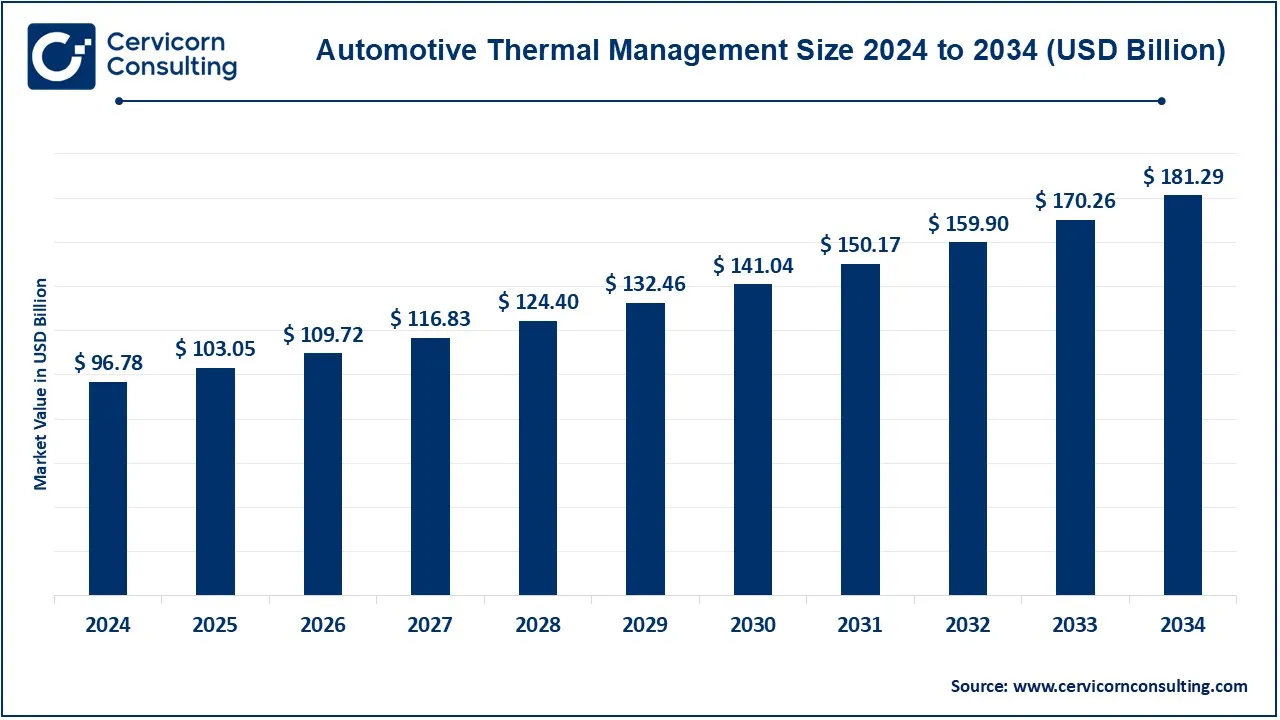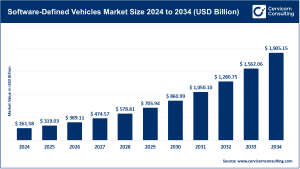Automotive Thermal Management Market Overview
The global automotive thermal management market is a cornerstone of modern vehicle engineering, contributing significantly to vehicle performance, passenger comfort, and energy efficiency. In 2024, the market was valued at USD 96.78 billion and is expected to reach around USD 181.29 billion by 2034, expanding at a CAGR of 6.47% between 2025 and 2034. Thermal management systems are critical for maintaining optimal operating temperatures for engines, powertrains, batteries, and electronic components in both internal combustion engine (ICE) vehicles and electric vehicles (EVs). The accelerating shift toward electrification, autonomous driving, and stricter emissions regulations has further amplified the importance of these solutions across the automotive industry.
Get a Free Sample: https://www.cervicornconsulting.com/sample/2502
Key Market Trends
Several technological, regulatory, and consumer trends are currently shaping the automotive thermal management landscape:
-
Electrification of Vehicles
-
Growing adoption of EVs and extended-range EVs has increased the demand for advanced thermal solutions.
-
Example: Companies are implementing liquid-cooled battery systems to enhance performance and safety in EVs, as observed in Tesla and Ford EV models.
-
-
Integration of Smart Technologies
-
Thermal management systems are increasingly being paired with AI and IoT-enabled monitoring, enabling real-time temperature regulation, energy optimization, and predictive maintenance.
-
Example: Modern HVAC systems in EVs adjust energy consumption dynamically based on battery status and cabin temperature.
-
-
Lightweight and Advanced Materials
-
Use of lightweight alloys, composites, and high-performance polymers improves efficiency, reduces system weight, and enhances overall vehicle performance.
-
Example: Companies like Denso and MAHLE are incorporating lightweight materials in heat exchangers and radiators to lower energy consumption.
-
-
Sustainability and Energy Efficiency
-
A global emphasis on fuel efficiency and emission reduction is driving OEMs to adopt energy-efficient thermal systems, including heat pumps and waste-heat recovery solutions.
-
Example: Valeo’s heat pump solutions improve EV driving range while reducing energy consumption for cabin heating.
-
-
Regulatory Compliance and Emission Norms
-
Strict emission standards, especially in Europe, North America, and Asia-Pacific, are compelling manufacturers to integrate advanced thermal systems that optimize fuel usage and reduce CO₂ emissions.
-
Example: Thermal management in ICE vehicles enhances fuel efficiency and ensures compliance with Euro 7 regulations.
-
Market Drivers
Several factors are fueling the growth of the automotive thermal management market:
-
Rising Electric Vehicle Adoption: The global EV market is expanding at a CAGR exceeding 20%, driving demand for efficient battery thermal management systems.
-
Stringent Emission Regulations: Worldwide emission standards require thermal systems that optimize engine efficiency and minimize CO₂ output.
-
Consumer Demand for Comfort and Performance: Growing expectations for optimized cabin temperature and energy-efficient climate control promote advanced HVAC and thermal solutions.
-
Technological Advancements: Innovations in battery cooling, heat exchangers, and AI-enabled thermal control systems are accelerating market expansion.
-
Insight: Battery cooling solutions are projected to represent over 25% of total thermal management system revenue by 2030.
-
-
Government Incentives for EVs: Subsidies, rebates, and tax benefits for EV adoption in regions like Europe, North America, and China indirectly boost thermal management system demand.
Impact of Trends and Drivers
The above trends and drivers are influencing multiple aspects of the automotive thermal management market:
-
Market Segments: EVs and hybrids are emerging as the largest consumers of thermal management solutions, particularly for battery cooling and heat pump systems, while ICE vehicles focus on energy-efficient radiators, HVAC systems, and heat exchangers.
-
Regional Influence:
-
North America: Growth driven by EV adoption, government incentives, and advanced R&D facilities.
-
Europe: High EV penetration and strict emission policies propel market expansion.
-
Asia-Pacific: China, Japan, and South Korea lead EV production and thermal innovation.
-
-
Applications: Advanced HVAC systems enhance passenger comfort, while battery and powertrain cooling systems ensure optimal EV and hybrid vehicle performance.
Challenges & Opportunities
Challenges:
-
High costs of advanced thermal systems may restrict adoption in budget vehicle segments.
-
Complexity in integrating new thermal solutions with existing ICE architectures or hybrid platforms.
Opportunities:
-
Growing demand for battery thermal management and heat pump systems offers significant expansion potential.
-
Integration of AI and IoT-based predictive thermal management provides opportunities for software-driven innovations.
Future Outlook
The automotive thermal management market is expected to continue robust growth over the next decade. The increasing adoption of EVs and autonomous vehicles, alongside innovations in smart HVAC, battery cooling, and energy-efficient technologies, will drive demand. Emerging trends, including AI-driven thermal control systems and lightweight materials, are set to redefine performance standards and energy efficiency benchmarks across the automotive sector.
Contact Us for a Detailed Overview: https://www.cervicornconsulting.com/contact-us


